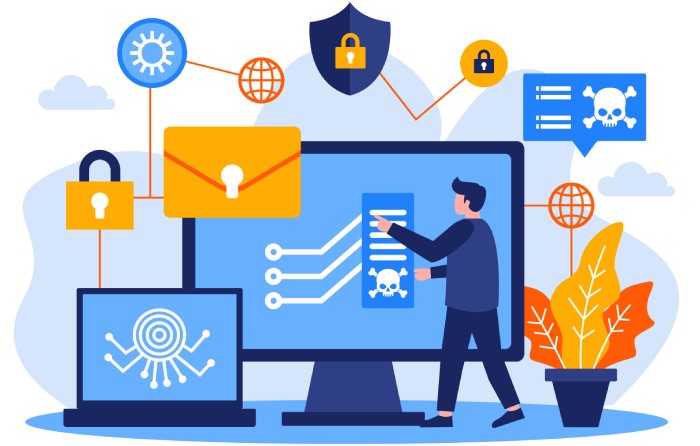According to a recent report, 85% of all organizations have been targets of phishing attacks. Like other phishing attacks, adversaries also use mobile phishing to trick users into sharing personal or critical organizational information. It is gradually becoming the most preferred mode of phishing by threat actors as there has been a significant increase in the use of mobile devices over the years.
What Is Mobile Phishing?
The scope of phishing has extended past the emails. Today, cyber adversaries have moved to techniques involving mobile phones to lure the end-user into divulging some crucial information, such as credentials to their bank accounts, credit card details, and so on. They use various innovative techniques, such as Screen Overlays (replicating the login page of a mobile application to trick the user), SMS Spoofing (sending phony messages to users, trying to get them to click on a phishing link), etc., which have proven highly lucrative for attackers.
Disturbing Statistics Involving (Mobile) Phishing Attacks
The following statistics highlight the severity of phishing and why it has become crucial for organizations to take this threat seriously.
- A staggering 97% of the users are not even able to recognize a phishing email.
- Adversaries launched 81% of the mobile phishing attacks outside of email in 2020.
- Mobile messaging applications carry out about 17% of attacks.
- Social networking applications are responsible for about 16% of mobile attacks.
Reasons Why Mobile Phishing Attacks Are On The Rise
Mobile devices are indispensable in today’s times for both individuals and businesses alike. However, another party seems to be having a field day, i.e., cyber adversaries, who take advantage of the following reasons and vulnerabilities to launch mobile phishing attacks.
- Increasing Use Of Mobile Applications: Every business wants to have an application for their product or service to make it easier for their customers to connect. The many results that pop up while searching for a particular application lead to confusion for the unaware user. The user may end up installing the wrong app, which adversaries may have created to steal the user’s credentials.
- Lack Of Identity Indicators: Adversaries employ unrecognizable malicious software such as keyloggers, making it difficult and, at times, impossible for regular consumers to identify and report the vulnerability.
- Lack Of Awareness: Users of mobile devices are so busy using them that they overlook the security aspect. Such lack of awareness, especially on the technical front, is one reason that has given rise to mobile phishing attacks.
- Small Screen size: As intriguing as it may sound, but the mobile phone’s small screen size is another reason mobile phishing is rising, as users cannot easily find out the vulnerabilities behind the applications. Because of the limited screen size, mobile users have difficulty distinguishing between the original or the edited logo of brands. Furthermore, browsers conceal the absolute URL of the requested web page because of the tiny screen size, which indirectly aids the attacker in tricking the users.
Strategies To Ensure Robust Mobile Phishing Protection
Along with adopting anti-phishing and anti-ransomware solutions, organizations can keep the following points in mind to thwart the malicious attempts of threat actors.
Using Latest Technologies And Methods
Deploying the latest technologies like artificial intelligence, DMARC, DKIM, robust encryption tools, effective spam filters, etc., are powerful ways to ensure the best phishing protection for mobile devices.
Keeping Updated On The Changing Patterns
Developers regularly update applications to fix the underlying vulnerabilities and bugs. Hence, users must check on these updates for their mobile devices as unpatched vulnerabilities are one of the prime ways through which threat actors are able to infiltrate mobile devices.
Ensuring Adequate Employee Training
Organizations must include adequate employee training in their policies. They must train the employees on aspects such as how to counter messages received from an unknown sender, identify whether a grammatical mistake is a genuine one or it is a potential phishing attack, check the authenticity of messages that require urgent action, etc.
Reporting Vulnerabilities
An adequately trained employee can most certainly identify phishing attempts, such as identifying a counterfeit web address from the real one or a vulnerability in the system that could end up being a gateway for future phishing attacks. However, if there are no proper communication channels within the organization, there could be a delay in reporting the vulnerabilities. Therefore, organizations must keep the communication channels as straightforward as possible for reporting vulnerabilities and phishing attacks, allowing the security and development teams to take prompt action.
Keeping Work-mobile Separate From Home-mobile
As an employer, one must ensure that their employees avoid mixing personal from professional, such as using mobile phones meant solely for business communication for their personal use, and vice-versa. Threat actors look for opportunities like these; for instance, an employee may have mistakenly used their personal device to carry out business transactions on an unsecured WiFi. This can potentially give the attacker access to the organization’s various information assets.
Final Words
Threat actors of today are as innovative as the rapidly-growing technologies of today’s times. Besides standard social engineering techniques, they have started to deploy more sophisticated methodologies, such as keylogging, screen overlay, SMS spoofing, etc., to trick the user into making a mistake.
No business wants to have their digital assets fall into the wrong hands; however, there is so much one can do when an employee makes the careless mistake of clicking on a phishing link. Hence, along with adopting the right phishing protection measures for your organization, it is also crucial to keep the employees adequately trained on identifying and mitigating phishing attacks.



